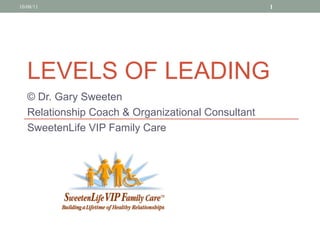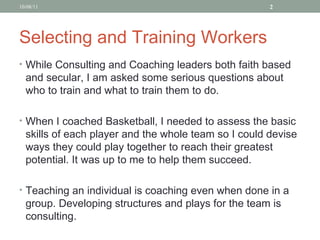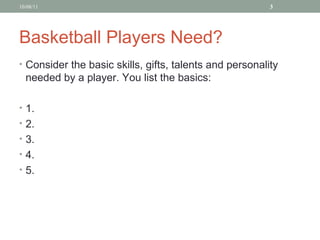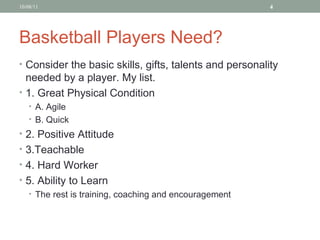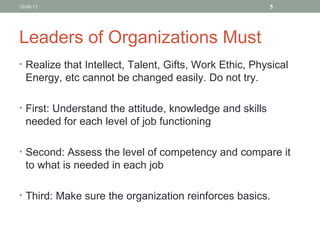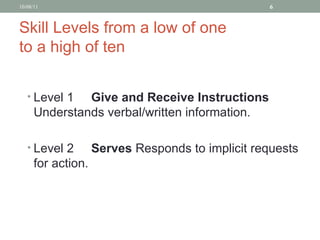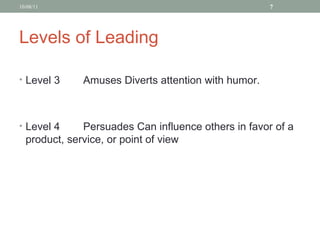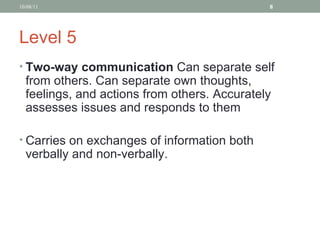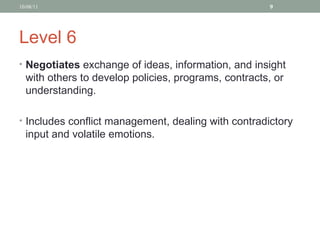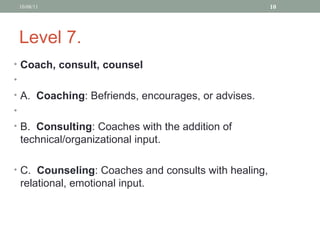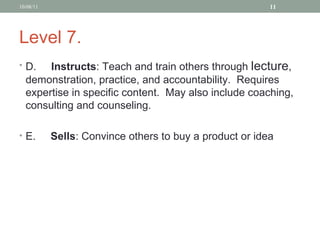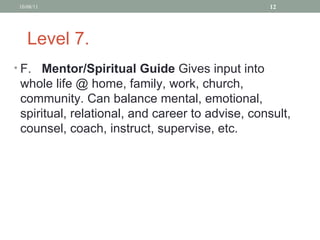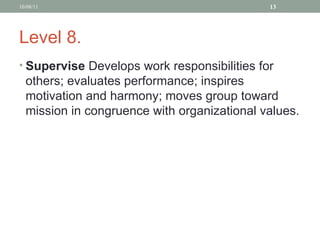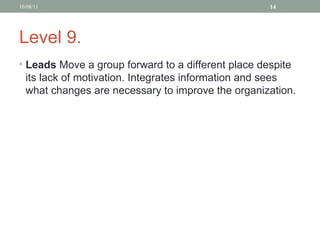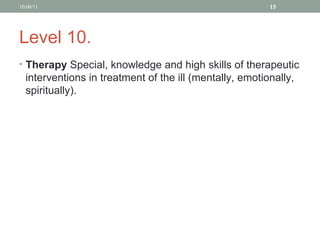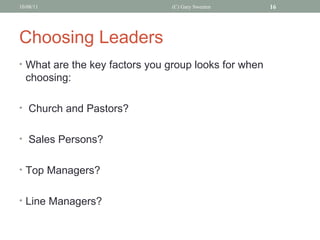Levels Of Leading
- 1. LEVELS OF LEADING ÂĐ Dr. Gary Sweeten Relationship Coach & Organizational Consultant SweetenLife VIP Family Care 10/08/11
- 2. Selecting and Training Workers While Consulting and Coaching leaders both faith based and secular, I am asked some serious questions about who to train and what to train them to do. When I coached Basketball, I needed to assess the basic skills of each player and the whole team so I could devise ways they could play together to reach their greatest potential. It was up to me to help them succeed. Teaching an individual is coaching even when done in a group. Developing structures and plays for the team is consulting. 10/08/11
- 3. Basketball Players Need? Consider the basic skills, gifts, talents and personality needed by a player. You list the basics: 1. 2. 3. 4. 5. 10/08/11
- 4. Basketball Players Need? Consider the basic skills, gifts, talents and personality needed by a player. My list. 1. Great Physical Condition A. Agile B. Quick 2. Positive Attitude 3.Teachable 4. Hard Worker 5. Ability to Learn The rest is training, coaching and encouragement 10/08/11
- 5. Leaders of Organizations Must Realize that Intellect, Talent, Gifts, Work Ethic, Physical Energy, etc cannot be changed easily. Do not try. First: Understand the attitude, knowledge and skills needed for each level of job functioning Second: Assess the level of competency and compare it to what is needed in each job Third: Make sure the organization reinforces basics. 10/08/11
- 6. Skill Levels from a low of one to a high of ten Level 1 Give and Receive Instructions Understands verbal/written information. Level 2 Serves Responds to implicit requests for action. 10/08/11
- 7. Levels of Leading Level 3 Amuses Diverts attention with humor. Level 4 Persuades Can influence others in favor of a product, service, or point of view 10/08/11
- 8. Level 5 Two-way communication Can separate self from others. Can separate own thoughts, feelings, and actions from others. Accurately assesses issues and responds to them Carries on exchanges of information both verbally and non-verbally. 10/08/11
- 9. Level 6 Negotiates exchange of ideas, information, and insight with others to develop policies, programs, contracts, or understanding. Includes conflict management, dealing with contradictory input and volatile emotions. 10/08/11
- 10. Level 7. Coach, consult, counsel A. Coaching : Befriends, encourages, or advises. B. Consulting : Coaches with the addition of technical/organizational input. C. Counseling : Coaches and consults with healing, relational, emotional input. 10/08/11
- 11. Level 7. D. ĖýĖýĖýĖý Instructs : Teach and train others through lecture , demonstration, practice, and accountability. Requires expertise in specific content. May also include coaching, consulting and counseling. E. Ėý ĖýĖýĖý Sells : Convince others to buy a product or idea 10/08/11
- 12. Level 7. F.ĖýĖýĖý Mentor/Spiritual Guide Gives input into whole life @ home, family, work, church, community. Can balance mental, emotional, spiritual, relational, and career to advise, consult, counsel, coach, instruct, supervise, etc. 10/08/11
- 13. Level 8. Supervise Develops work responsibilities for others; evaluates performance; inspires motivation and harmony; moves group toward mission in congruence with organizational values. 10/08/11
- 14. Level 9. Leads Move a group forward to a different place despite its lack of motivation. Integrates information and sees what changes are necessary to improve the organization. 10/08/11
- 15. Level 10. Therapy Special, knowledge and high skills of therapeutic interventions in treatment of the ill (mentally, emotionally, spiritually). 10/08/11
- 16. Choosing Leaders What are the key factors you group looks for when choosing: Church and Pastors? Sales Persons? Top Managers? Line Managers? (C) Gary Sweeten 10/08/11

